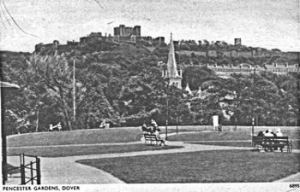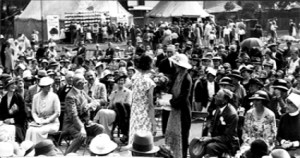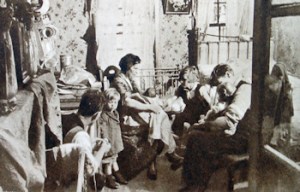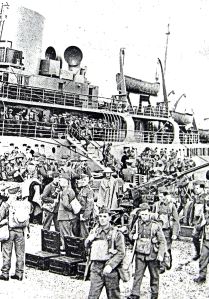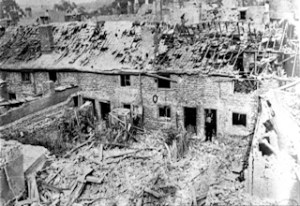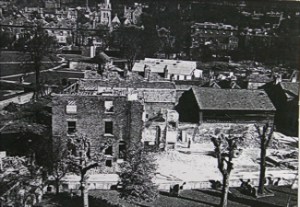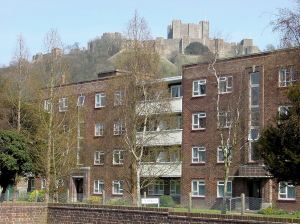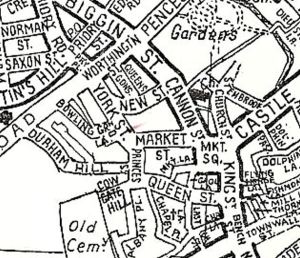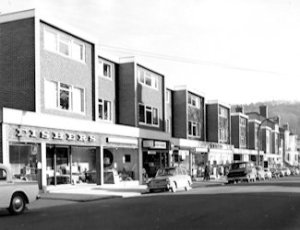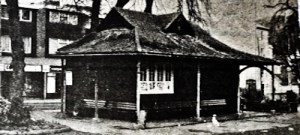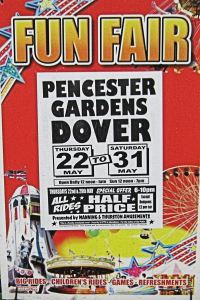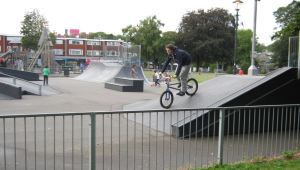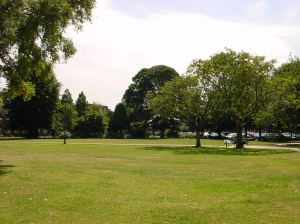Part One of the Stembrook Tannery to Pencester Gardens story looked at the development of the area from medieval times to the 1920s. For much of that time a large part of the site was owned by the Maison Dieu and stretched from present day Ladywell to Dieu Stone Lane. On the east side of the River Dour was a narrow, twisty, lane called Charlton Back Lane and to the west the Market Place, St Mary’s Church and Biggin Street. The Maison Dieu estate was sold at the time of the Reformation (1529-1536) and a large mansion with beautiful gardens was built and occupied by the Stokes family, followed by the Wivell family, the Gunman family and the Jarvis family. They occupied the estate for the next 300years until George Knollis Jarvis (1803-1873) finally sold it in 1854.
Just north of the mansion, a public footpath that ran from Biggin Street towards the Castle bisected the grounds of the estate. When the mansion was sold the footpath eventually became Pencester Road. It was the southern part of the estate that later became Pencester Gardens. To the west of this part of the original site, between Dieu Stone Lane and the Dour, was the ancient Church Street. There was also a short thoroughfare from the back of St Mary’s Church to the Market Place otherwise the Stembrook Tannery occupied the rest of the area.

Castle Street late 19th century looking towards the Castle. On the left is Stembrook corn mill. Dover Museum
In 1797 a Military Road was laid from the Castle to the Western Heights, following another ancient footpath that ran from St James Church, past the tannery to the Market Place and from there up to the Western Heights. During the Napoleonic Wars (1793-1815), alongside this Military Road and next to the River Dour, in 1792 the Military built the Stembrook corn mill. At the end of the Wars the Military Road was handed over to the Deal Turnpike Trust and abutting Church Street, Caroline Place cottages were built. Over shadowing the cottages and between them and the tannery was the Artillery Volunteers’ Institute.
A consortium of local businessmen laid out Castle Street in 1829, following the line of the Military Road from the top of the ancient Church Street eastwards. A few years later the Paving Commission extended the ancient Stembrook from Dolphin Lane to the Church Street and Caroline Place junction. The Castle Street bridge was built and the Stembrook thoroughfare on the sea side of Castle Street was renamed Dolphin Place. Around about 1840 cottages and poorer workers residences were built on Church Place and the Stembrook thoroughfare, which had been extended to Dieu Stone Lane.
The Inter-War Period
The southern portion of the former mansion site was acquired by the Crundall family for use as a timber yard. Following World War I (1914-1918) Dover Corporation were considering the future of the yard, or Pencester Meadow as it was called, as the owner, Sir William Crundall (1847-1934) was talking of selling it. In 1922 the Stembrook tannery came on the market and the following year, the Corporation voted to ban the practice of tanning in Dover.
At the time the country was sliding into a deep economic depression – there were 1,400 men out of work in Dover. Dover’s Mayor, William George Lewis (1850-1924), prime concern was to pursue projects that would provide employment and the Corporation decided to purchase both pieces of land. Their intention was to provide a recreation area in what was then a densely populated part of town. However, the proposal was met with a great deal of local hostility that ended in a Public Inquiry. This was held on 16 March 1923 in the Council Chamber of the then Town Hall now the Maison Dieu. For details see Part One of Stembrook Tannery to Pencester Gardens.
The Secretary of State for Health (1924-1929), Neville Chamberlain (1869-1940) gave his approval for the creation of recreational area. The project was to be financed by a loan of £2,900 repayable over 20 years, by the Ministry of Health to lay out the ground as a play area and gardens. Also consent was given for a £4,200 loan, repayable over 50 years, towards the £5,000 cost of buying the Meadow. Although the Corporation were jubilant, the loan was £200 short of the required sum but this Mayor Lewis personally covered. Work began in 1924 on what was renamed Pencester Gardens. Mayor Lewis, however, never saw his special project completed for he died on 2 May that year.

Jarvis Estate c1830-1850 summer house east of Maison Dieu beyond the lawn of what is now Pencester Gardens. George Jarvis
Once the sale was completed those who criticised the purchase were quick to point out that there was a right of way across Pencester Meadow from Castle Street and Stembrook to Pencester Road. This meant that the Corporation could not limit access to the site. With this in mind, William E Boulton Smith (1883-1975), the Borough Engineer, submitted two alternative schemes. The first was a pleasure ornamental garden centering on the existing George IV (1820-1830) summer house, built when the Jarvis family owned the estate and close to the present Pencester Road, plus a children’s playground. The second option was four hard tennis courts and one grass court plus a children’s playground. The Corporation opted for the first suggestion, which was estimated to cost £2,940 including lavatories and shelters. Under the supervision of Edwin Pott (1882-1962), the Borough Gardens Superintendent, local unemployed men were to be recruited to provide the labour required.
The Stembrook area, to the south of the Gardens sloped down from Castle Street, comprised of tiny cottages, crowded tenements and the pubs of Stembrook, Church Street, Chapel Place and Caroline Place. Close to Church Place on Stembrook was the Corporation’s Waterworks Stores, Worsfold and Hayward’s stores while the auction rooms were on Church Street and nearby was Igglesden & Son’s bakehouse. The pubs in the area included the Ancient Druids on Stembrook while on Church Street there was the Burlington Inn and the Star Inn. Otherwise, poor families, of which a large number were headed by World War I widows, inhabited most of the tenement buildings. Many of the remaining tenement families were headed by former military and naval personnel, many of whom were handicapped by injury sustained during the War.
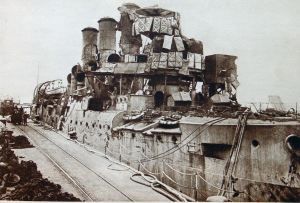
Vindictive on her return to Dover following Zeebrugge Raid, after which she was used to blockade Ostend harbour in the Ostend Raid. Doyle collection
One such person was Francis O’Connor (1897-1974) of 5 Caroline Place, who had served under Vice-Admiral Roger John Brownlow Keyes (1872-1945) of the Dover Patrol, on the Zeebrugge Raid of 23 April 1917 and the subsequent Ostend Raid of 10 May 1917. The Ostend raid was meant to be identical to the successful Zeebrugge Raid and centred on sinking the Vindictive at the mouth of Ostend Harbour. Unfortunately, after a fierce battle the ship ran aground at the last moment so only partially blocked the harbour. O’Connor was among the skeleton crew on the Vindictive and had been badly injured.
On demobilisation O’Connor, like other injured personnel, was given a scanty War pension of 12s (60p) a week on which he was expected to keep his wife and family. He had tried to find work but there was very little and employers preferred healthy men. Further, although he had suffered serious injuries, due to the lack of a health service free at the point of use, he had to pay for most of his medical treatments as well as those of his family. On Friday 31 October 1925, at about 23.15hours, O’Connor brought the town’s attention to his plight when he rang the Zeebrugge Bell hanging outside the then Town Hall. He was arrested for disturbing the peace and spent the rest of the night in the nearby police station cells. Next morning he appeared in court, the Chief Magistrate of which was the Mayor (1925-1926), Captain Thomas Bodley Scott (1880-1928). O’Connor told the court of how he gained his injuries and his plight as a War veteran. Along with the other magistrates, Mayor Bodley Scott listened but showed no emotion and the retinue left the Court for deliberation.

Zeebrugge Bell outside the Maison Dieu, formerly Dover Town Hall, that was rung by Francis O’Connor on the night of Friday 31 October 1925. Alan Sencicle
The members of the Bench return to the Court and their attitude was serious and cold. Head bowed, O’Connor expected the worse so could not believe his ears when Mayor Scott gravely announced that under the circumstances all charges would be dropped! Further, the Mayor announced, he would personally write to the pension authorities and demand that O’Connor was to receive ‘better treatment’. Finally, the Mayor said, he would write to a recently formed organisation that specialised in helping those injured while fighting for the country. Whether Francis O’Connor was recruited to work on Pancester Gardens is unknown but on 15 March 1974 a small notice appeared in the local papers. It stated that Francis O’Connor, the last survivor of the Dover Patrol cruiser Vindictive, which was sunk at Ostend, had died the previous Sunday. He was aged 77 and lived in the Battle of Britain Homes overlooking York Street.
Francis O’Connor’s experienced following the War was far from unique. Of those men who returned, 1.75 million were suffering some kind of disability and half of those were permanently disabled. Most received a disability pension from the Ministry of Pensions but this tended to be tokenistic and it varied in scale and in accordance with the type and severity of disability. To try and deal with the increasing unemployment of that era, councils introduced unemployment schemes similar to the one that created Pencester Gardens. However, like other employers, Dover Corporation preferred to take on unemployed able-bodied men. Long before the War ended a number of altruistic minded organisations had been set up to try and deal with the plight of the disabled ex-servicemen and on 15 May 1921 four national ones joined together to form the British Legion. That year, on Remembrance Day – 11 November – the British Legion organise the Poppy Appeal to help members of the Royal Navy, British Army, Royal Air Force, veterans and their families all year round. One of those helped, at the instigation of Mayor Scott, was Francis O’Connor and his family.
The proposed Pencester Gardens were laid out under the direction of Boulton Smith assisted by Edwin Pott and a significant number of the local unemployed were recruited. Then just prior to work starting, the Corporation decided to have an 18-hole miniture golf course on what they owned of the former tannery site, increasing the cost of the enterprise to £7,500. In 1927, the first public fete was held in the Gardens and this was to raise money for the Royal Victoria Hospital, then Dover’s General Hospital.
That year also saw about 50 pupils from the Duke of York’s School present their ‘Toy Soldiers’ routine to a large crowd. The boys wore bright blue or red jackets, white trousers and black ‘bearskin’ hats similar to look at as those worn by the Guards but made out of brown paper and painted black! Red circles were painted on the boys’ cheeks and they carried wooden rifles. As Toy Soldiers, the boys performed a series of drills that included a mock battle without any commands. So successful was the event that they were asked to put on the show elsewhere and by World War II (1939-1945), the routine was internationally famous!
At about this time, the firm Castle Concrete, founded by Captain V D’Oyley Noble who lived in Victoria Park, bought the remainder of the old tannery site for workshops. Their main offices were at 20 Castle Street and backed onto the tannery site where they planned to make concrete and breeze blocks. However, at 17.15hrs on Sunday 6 January 1929, a fire broke out in one of Castle Concrete buildings and quickly spread. Following the fire the Company offered the site to the Corporation at a good price and would have enable them to extend Pencester Gardens. However, the council did not have the financial resources available so had to decline.
After less than five years the Corporation’s Entertainment’s’ Committee, in 1930, voted to move the miniture golf course to Granville Gardens on the Seafront. While on Pencester Gardens it was cheap for customers and had been open every day during the summer months, but this was proving costly. In order for tourists to use the facility, so they said, it was to be moved to Granville Gardens where it would be open on a Sunday and the price was to increase. There was a public outcry and although it was moved to the new location, the miniature golf course opened everyday during the summer months with a special concession for locals.
Pencester Gardens, was the centre of many of the town’s activities aimed at children. In her book, in her Trawling the River of Time (self-published) Mary Morrison tells us that ‘Pencester Gardens was a magical place. The magnificent Dover Castle towered over the gardens, on the skyline overlooking all below. The river Dour flowed along one side and there were swings and places to skate and play all manner of ball games.’ Since 1927, one of the highlights of Dover’s social calendar was the annual Royal Victoria Hospital Fete. Up until 1948 patients had to pay for care and as many could not afford hospital care they relied on financial help from charities. The hospitals also relied on financial contributions and the money raised at the annual Royal Victoria Hospital Fete was a major contribution in keeping Dover’s hospital functioning. The major prize was a car and every shop and garage in the town also provided prizes and displayed a number in their window. The general public bought individually numbered programmes and then would go around the town, checking each shop and garage window to see if the number of their programme matched the one displayed.
The celebrations included the carnival when horse-drawn and motorised vehicles, freely provided by the owners, pulled floats – decked out trailers put together by different businesses. They drove around the town in a convoy during which time they were judged with prizes awarded. On the actual day of the Hospital fete, various events were held and there were sideshows and victualling tents providing edible goodies and non-alcoholic drinks. In the evening the Duke of York’s School pupils put on, by this time, the nationally famous Toy Soldiers display, the highlight of which was the climax, a battle followed by the firing of shots and all the boys stiffly falling, as wooden soldiers would, at the same time!
Albeit, by this time unemployment in Dover was greater than it had been at any time in the 1920s and continued to rise, reaching a peak in 1932 with 2,624 men out of work. Locals had long since stopped enjoying any facilities requiring payment but by this time, starvation was rife and children also had to do without. It was not until January 1933 that a Corporation ran soup kitchen was opened. This was at the instigation of the Mayor (1932-1934) Alderman Frederick Morecroft (1879-1961) and was held in the cellars of the Town Hall. The facility provided 1,500 dinners a week to needy children.
In 1934, the Dover Unemployed Association held a carnival procession and fete in Pencester Gardens. This raised a total of £218, reduced to only £70 after expenses were paid including renting the Gardens. Nonetheless, out of the proceeds the Dover Unemployed Association retained 50% and the remainder they gave to the Gordon Boys’ Orphanage in St James Street, the Girls’ Orphan Home in Folkestone Road and the Lifeboat Fund. Dover lifeboat, at that time was the state of the art 64foot Sir William Hillary that was voluntarily manned by a crew that included some who were unemployed. Ironically, the boat had been brought on station to deal with the increasing number of affluent adventurous that had taken up recreational flying and ended up crashing into the Channel.
The start of a Recovery and World War II
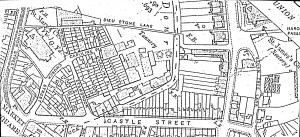
Map (c1900) of the Stembrook area, showing the tanyard site, Castle Street, Caroline Place and Dieu Stone Lane. The eastern area of the site is the part Dover Corporation purchased using a Compulsory Order.
In late 1935 Castle Concrete again put their old Tanyard holdings on the market but the Corporation could not afford to purchase it. In February 1936 a plan was submitted on behalf of Fyson and Nevill of Continental Motors, for the erection of a motor garage and showrooms on the Castle Street part of the site. This was followed by a second application for eight lock-up garages on an adjacent site fronting Caroline Place. The agents made it clear that Fyson and Nevill were looking at redeveloping the eastern part of the old tannery site, which was open land and close to Dieu Stone Lane. On the northern side of the Lane were Pencester Gardens and the Corporation were none too happy. Meetings were arranged with a view to the Corporation buying the land from Fyson and Nevill. However, by 9 September 1935, having not acquired the remainder of the site for a price they could afford, the Corporation started Compulsory Purchase proceedings.

Annual Dog show on Pencester Gardens organised by the Dover Brotherhood and Sisterhood. Lady Anne Davenport presenting the ‘Davenport Cup’ for the best dog in show to Mrs C.A. Jenkins of Folkestone. Left to right, Mr A. Maxfield (Judge), Sir Henry Davenport (1866-1941), Mrs Jenkins, Lady Anne and Mrs Llewellyn Langley. The Winning dog was a black and white Borzoi, name not given.
On 2 April 1937 the Corporation, having secured a Compulsory Purchase Order, forced Fyson and Nevill to sign the contract to transfer the parcel of land at the east side of the old tanyard site. The agreed sale price was £2,400. As far as the Corporation were concerned, this came just in time as the Coronation of King George VI (1936-1952) was to be held on Wednesday 12 May 1937. The event was celebrated by the town on Pencester Gardens and the Mayor, Alderman George Madgett Norman (1866-1953), planted commemorative trees in the Gardens and on the newly acquire land. Other activities included the annual dog show organised by the Dover Brotherhood and Sisterhood that attracted breeds from all over East Kent. The highlight of the event was the Davenport Cup, given for the best dog in the show and on this occasion was presented by Lady Ann Frances Davenport (1880-1966). The winning dog was a black and white Borzoi, generally described ‘as longhaired greyhounds’, owned by Mrs C.A. Jenkins of Folkestone.
The economy was slowly picking up and during the Mayority of Alderman Morecroft, the Corporation planned a slum clearance programme. This, the Mayor said, was to create both jobs and healthy homes and the strategy initially focused on the Pier District of Dover. Proving successful, by 1937, the Corporation decided to upgrade the town centre housing and announced that homes were to be demolished in the Stembrook area. This caused consternation, not only from the folks who lived in the area but also from the more affluent residents who either owned the properties or who were concerned over possible rate increases.
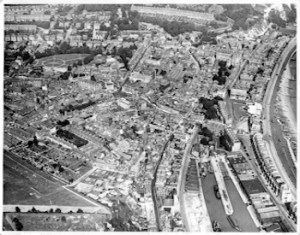
Aerial view of central Dover in the 1930s Pencester Gardens is easily identifiable as the open space in the top left quadrant with circular and cross footpaths the Stembrook area is on the sea side. Dover Museum
In order to emphasis the need for healthy, well built new homes, the Corporation cited as an example, the state of the tenements that made up number 14 Stembrook supported by a report made by the Corporation Sanitary department. The place was described as overcrowded, damp, with the walls held together by layers of wallpaper. There was one communal lavatory that served the block and a shared cold water tap. Further, the statement went on, the deplorable condition of the property was typical of most of the properties in the Stembrook, Woolcomber Street and Trevanion Street areas, Pleasant Row and Queen’s Court in the centre of Dover. It was recommended that all should replaced with new homes. Dover Corporation councillors agreed but the owners of all these properties and many of the residents did not and a series of Public Inquiries were called.
At the Public Inquiry, the Ministry of Housing appointed Chairman looked at groups of areas and the proposed demolition of Stembrook area was looked at in conjunction with the demolition of properties in the Woolcomber Street and Trevanion Street areas. The Corporation told the Chairman that in order to maintain the community character they proposed to re-house the residents of the Stembrook area in one of the suburban developments they were undertaking, possibly in the Union Road / St Radigund’s Road area. Once the land at Stembrook was cleared, they proposed to build new swimming baths on the site and this was estimated to cost £48,446.
Permission was given and the Corporation acquired the Stembrook area in three separate blocks in 1937 and 1938. The final block was Caroline Place. Residents were re-housed as homes were completed and then their former homes were demolished. Demolition began in 1938. However, the dark clouds of World War II were gathering so it was not long after work on the project began before the new builds and the demolition was stopped. The swimming pool project was put on hold.
The Corporations preparations for war included trench shelters and one was started next to the children’s playground in Pencester Gardens. However, the cost of finishing it by making it bombproof and habitable was such that following the Munich Appeasement Agreement of 29 September 1938, the Corporation, ordered the hole to be filled in! With the renewed threat of War, in April 1939, the digging was restarted and included making it bombproof and habitable. The size was also extended to accommodate 426 people and smaller trenches were dug. All the trenches were lined with concrete and covered with two feet of earth. Inside each shelter was seating and chemical lavatories. At the same time in the Gardens, next to the established public lavatories, a decontamination centre was erected.
From the outbreak of World War II on 3 September 1939, as in World War I, Dover came under Military Rule as Fortress Dover. Albeit, up until the fall of Dunkirk on 26 May 1940, the direct effects of the War were merely an inconvenience. The cross Channel ferries were commandeered for War Service and at first were mainly used to carry members of the British Expeditionary Force to Europe. There was an influx of military and naval personnel into the town, many of which were billeted with local families. Children from London were sent to Dover and East Kent towns for safety. Refugees, however, arrived on an assortment of craft from mainland Europe being taken Dover’s Town Hall at the Maison Dieu before they were moved on. The evacuated children from London attended local schools and special entertainments were laid on, including in Pencester Gardens. However, as the European War seemed far away the children drifted back to their homes in London.
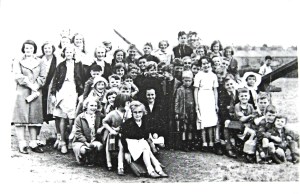
Children who lived in the Ropewalk and Aycliffe about to be evacuated from Dover in May 1940. Ray Langabee
Things changed dramatically at the beginning of May 1940 as the Germans moved closer to the European Channel ports. On 22 May, the Germans captured Amiens, France, and in Dieppe harbour on 23 May, a stick of five bombs hit the 2,789-ton twin-screw cross-Channel ferry, Maid of Kent, which had been utilised as a hospital ship. The flames spread rapidly, killing and injuring many on board and reached a crowded hospital train alongside. On the night of 24 May, Boulogne fell and Calais quickly followed. Dover’s children were evacuated to the safety of South Wales.
As the Germans closed in, the British Expeditionary Force, along with their French and Belgium comrades, made their way to Dunkirk on the French coast. On the 26 May, Operation Dynamo was put into operation under the command of Vice-Admiral Bertram Ramsay (1883-1945), who was in command at Fortress Dover. Between 26 May and 4 June 1940, 338,226 British and Allied troops were evacuated from the beaches of Dunkirk and Dover played a crucial part. Pencester Gardens was used as a temporary holding area before the evacuated men were moved elsewhere.
Shortly after, the Germans launched Operation Sealion – the invasion of Britain. From 10 July 1940, the first day of the Battle of Britain (10 July-31 October 1940) right up until 26 September 1944, Dover hardly had any respite from bombardment. Throughout this period, air raid warnings of bomb attacks were regularly sounded and then on 12 August 1940 shelling from German guns on the French coast began. By October a special shelling air raid warning siren – double alert – was introduced. This, however, was too late for Edith Cameron (bc1878-1940) of 10 Church Street. On the afternoon of Thursday 26 September 1940, Edith was going about her daily business when the air raid siren was sounded. Seconds later a shell hit her home that partly collapsed and buried Edith. Even though children had been moved far away from the town, many found their own way back. Next door to Edith lived twelve-years-old James Robert Holman (bc1928-1940). He too was buried and when rescuers arrived he was still alive but sadly he died the following day.
At the time of the Battle of Britain, the German invasion was expected any day but on 12 October 1940 Hitler postponed the actual invasion of Britain until the following year. Nonetheless, the aggression was maintained such that during the two weeks following Sunday 20 October 1940, 350 shells fell on the town. Albert Victor Ashbee, known as Frank (1883-1940), the landlord of the Ancient Druids pub on Stembrook was walking along St James Street when he was killed. As noted the shelling did not relent until 26 September 1944 and much of the town centre was devastated. Typically, on 31 March 1941 a shell hit Flashman’s Depository in Dieu Stone Lane, the building along with the graves in the nearby St Mary’s Churchyard were damaged by fire. Another shell totally wrecked the Flashman building on 4 October 1943 and that year saw the Company’s showrooms in Market Square hit by shelling and a passer-by was seriously injured. Prior to the War, the town’s bus station was located in Market Square but shortly after an air raid on 23 March 1942, when 17year-old Ella Dixon (1925-1942) of East Langdon was killed, the bus station was moved to Pencester Road. Although this was a temporary measure – it is still there!
By the summer of 1943, although the bombardment continued, it was apparent that there was an acceptance that life could take on a semblance of normality. Further, many of the children had returned to the town and local teachers, who had remained, were reluctantly given permission to re-open schools. Due to the shortage of teachers, the lack of classrooms, books, materials and general facilities, education was provided on a part-time basis. For the rest of the time children were often left to their own devices. Facilities in Pencester Gardens opened and the Corporation even considered re-opening the putting green.
At the nearby British Restaurant, on Stembrook, civilians could purchase a three-course meals, ‘off the ration’, for 9d (approx. 4p) and half that price for children accompanying an adult. Originally called Community Feeding Centres, British Restaurants were set up by the Ministry of Food. In Dover the council ran it with voluntary help on a non-profit basis. Each meal contained one serving of meat, game, poultry, fish, eggs, or cheese and vegetables that were a good source of vitamin C, such as cabbage, were classed as staple and therefore served with every meal. At Dover, meals were prepared on site and because it was a large centre, the diners had choices for each course.
Outside, the shelling continued and while children were playing in Pencester Gardens, on the afternoon of Saturday 25 September 1943 a shell exploded hitting 11 Pencester Road, next to the Gardens. Just over a week later, in the late evening of 3 October 1943, another shell exploded, this time in Pencester Gardens. It also destroyed a number of buildings including the Corporation slipper baths at Biggin Hall, the rear part of the Technical College and the police station both of which were on Ladywell.
Following the D-Day Landings of June 1944, the shelling significantly increased. Although the highest concentration of V1 flying bombs was, following the Landings, towards London and the Home counties. As the Allied troops moved north the robot bombers were moved and their impact on East Kent increased. The last V1 was shot down near Hythe on the afternoon of 1 September 1944. By this time the Canadian Army was fighting its way towards the cross Channel port of Calais and the shelling of Dover intensified. Dover’s Civil Defence, under Staff Officer Reginald Cyril Percy Leppard (1900-1994), had ten Heavy Rescue Squads and they were all constantly kept busy. At about 02.00hrs on Saturday 2 September 26 shells rained on the town, one of which was an 18-inch armour piercing shell. This burst on Stembook, destroying most of the properties. One of the buildings left standing was the popular British Restaurant.
Regardless, as the weather on the afternoon of Sunday 3 September was sunny and warm, Pencester Gardens was crowded. A group of sailors taking a spot of leave, meandered into the Gardens and although shattered building surrounded the place, the atmosphere within was peaceful. Children played on the swings or with balls or were just laughing and running around. Young women, wearing their Sunday best were chatting to United States soldiers and Mums, many with prams and pushchairs, were sitting about chatting. The sailors lay or sat down on the grass and were enjoying the sun and the sounds of normality, when suddenly a shell burst almost overhead.
Immediately, everyone raced for the shelters with the sailors and soldiers carrying slower children or pushing the prams and pushchairs. The next shell fell just outside one of the shelters but it seemed that all were safely inside. Albeit, a sailor and a US soldier took one last look outside and saw a few children trying to help not very ambulant old folk cross the recently created deep crater. The sailors and the soldiers went to help and once everyone was inside the doors were closed. One of the sailors later wrote that the noise of the bombardment outside could be heard but the locals were totally unfazed, chatting and laughing as they had been outside before the shelling had started – shelling was such a regular occurrence!
Monday 25 September 1944 saw the start of 48 hours of the most intense shelling that Dover suffered during the War. The Germans stationed near Cap Blanc Nez, outside Calais, were determined to use all their ammunition before the Canadian forces arrived. The streets of Dover were deserted as nearly everyone was seeking shelter from the bombardment – only four people were killed and three seriously injured. Tuesday 26 September saw even heavier shelling and much of the Stembrook area that was still standing the previous weekend, succumbed. The last shell that day exploded at 19.15hours at the corner of Castle Street and Church Street, destroying Hubbard’s Umbrella Shop in Castle Street – A Dover Society Plaque marks the area where the shop once stood. At the time, Dovorians were unsure whether the bombardment was all over for it was not until Saturday 30 September that the Mayor (1937-1944) Alderman James Robinson Cairns (1880-1969), announced that it was! On 1 October the Commander in Chief of the German Army, Field Marshal Ferdinand Schoerner (1892-1973) announced that Calais and the Channel Ports, except for Dunkirk, had surrendered unconditionally to the Canadian forces.
Post War to 1960
During the War, the Corporation had worked on a plan for the reconstruction of the town when peace came. Because the attacks on Dover had increased significantly following the D-Day landings (6 June 1944) and while the Germans were being driven out of France, the town was devastated beyond recognition. When the bombardment ceased it was estimated that the war damage sustained by the town was proportionally greater than in any other town throughout the country. 957 houses had been destroyed; 898 seriously damaged but in part fit for uneasy habitation; and 6,705 were less seriously damaged. Public buildings, general businesses and industrial premises were also badly damaged.
At the time, Dover’s Town Clerk was solicitor James Alexander Johnson (1908-1998), known, not particularly affectionately, as James A. When he was appointed in December 1944 he had already earned the reputation of having a brilliant incisive mind and dogged determination. James A. was to use these skills to propel the reconstruction of Dover, based on the original plans drawn up by his predecessor and the Corporation. To give weight to the proposal Town Planner, Professor Patrick Abercrombie (1879-1957) was hired for a fee of 1000 guineas (£1,050), to produce a Reconstruction Plan from which the Corporation could, ‘proceed systematically over the next twenty years … (and) … which will beautify Dover and make it worthier of its ancient heritage.‘
Immediately the Professor submitted an ‘Area of Extensive War Damage‘ application to the Government. This was given affirmation in January 1946, at the same time as Abercrombie’s report was published in which he made a number of proposals including redeveloping the Stembrook area with blocks of high quality flats. The Professor’s Plan went before the Corporation in February 1947, who having made some modifications asked the Government for a Declaration Order. This covered 252 acres, extending from Buckland Bridge through Charlton Green to the Seafront. The proposals were fully supported by the Town Clerk, James A, who put forward the argument to the Government Inspector. He also asked for a number of immediate Compulsory Purchase Orders to be implemented, one of which covered the Stembrook area.
The Orders, if granted, enabled the Corporation to acquire the property at site value only and many owners objected. On 12 August 1947 a Public Inquiry was held under the auspices of the Ministry of Health at the Town Hall (now the Maison Dieu). William Scrivens, a barrister with an excellent reputation in such proceedings, represented the objectors. He contended that the war damaged condition of the properties were so bad because the Corporation had refused to allow repairs to be undertaken and the owners had been denied the right of ‘cost of works allowances’ prior to the application for Compulsory Purchase orders. Further, those who had lost property due to War damage were uncertain as to what compensation they would receive, as the corporation had been deliberately unhelpful.
James A contended that all the properties in the Stembrook area were uninhabitable and that was why no attempt had been made at undertaking repairs. Scrivens responded by citing Caroline Place, where numbers 1, 5, 6, 8, 9, 14, 19, 24, 25 and 25A were not only still standing but were inhabited! To these, he said, other buildings in the Stembrook area were still standing, including the Ancient Druid’s public house and most were inhabited. Although Scriven’s put forward a strong argument the Ministry of Health granted Compulsory Purchase Orders for all the properties in the Stembrook area at site value. The adjudicator, however admonished the corporation for not informing property owners that ‘cost of works allowances’ were dealt with by the War Damage Commission and that the corporation should have both advised and made application forms available to the property owners.
The winter of 1946-1947 was one of the harshest on record and caused severe economic hardships including a major shortage of fuel resulting in a 20% cut in the supply of electricity. Schools were closed in Dover, due to heating pipes freezing and due to ice-flows the Dover-Ostend ferry service ceased operating. In March 1947, a warm spell rapidly melted the snow and ice with the result that the Dour overflowed its banks causing severe flooding in the centre of Dover. Most of Dover’s recently opened or reopened industries were on short time and some closed, never to reopen. Rationing, which had been introduced on 8 January 1940 and becoming stricter as the War progressed, became increasingly severe after the War due to the continual shortages. The austerity and its associated effects on health and well being was having a depressing effect and leading to political unrest.

Sidney Doble carrying the Olympic Torch through Dover following arrival on HMS Bicester 28 July 1948 pix Graphic Union. Dover Library
Appropriately, due to the British economic climate, the 1948 Summer Olympic Games, which were held in London, were called the Austerity Games. Nonetheless, the government hoped that they would be a national moral booster. The country could not afford to build new venues so the events were held in Wembley Stadium, London, the Empire Pool in Wembley Park and the arts competition – the last one held in the Olympic Games – at the Victoria and Albert Museum. The Olympians were housed with locals in the Wembley area, in army and RAF camps and in London colleges. The Olympic torch left Greece on 17 July 1948 and eventually was brought across the Channel on Wednesday 28 July aboard HMS Bicester arriving at the port of Dover at 20.25hours. On disembarkation the Olympic torch was carried through the town before being passed on by Sidney Henry Doble (1908-2004) of the renamed Dover and District Co-operative Society Sports Club.

Pencester Gardens c1950s. Left the ‘comfort shelter’ that included toilets and a shelter with seating. David Iron Collection
In Pencester Gardens the trench shelters had been removed and the holes filled in. The Corporation also agreed to get rid of the Decontamination Centre to enable the existing public conveniences to be extended. The number of male and female lavatories were increased and two rooms were provided for male and female attendants. An awning was erected on the outside giving covered shelter with seating accommodation for persons using the Gardens. The cost was estimated at £1,300 and an application was made to the Ministry of Health for a loan for the same amount and the facility was built. This proved popular but due to the increasing cost of upkeep much of the facility was demolished in the 1960s.
In the summer of 1949 the new Chairman of the Housing Committee, Conservative Councillor Sidney Frederick Kingsland (1900-1960) proposed that the Corporation should concentrate on re-building on some of the vacant sites near the town centre. In September the Principal Regional Officer of the Ministry of Health asked them to furnish details of their proposals. Amongst the Corporation’s recommendations were flats at the southern end of Pencester Gardens. In July that year, members of the Housing Committee visited other towns that had built council flats and were particularly interested in those in which central heating systems had been installed. They therefore proposed the erection of a block of flats of not more than four storeys, without lifts but incorporating a system of central heating.

Pencester Court during erection, nearby is the Martin Walter Garage on former bombsite c1950. Arthur Couch Dover Mercury
In 1946 Martin Walter Ltd with motor garages in Folkestone and Broadstairs and during the pre-war had premises in Dover, that incorporated Dover’s Tapleys Motors. Shortly after, they erected new premises on the war torn area in Castle Street / Stembrook area. About the same time the Corporation supplied details of plans for re-development of the Stembrook area in the hope that the Ministry of Health would give approval for that scheme. They planned to incorporate the site of the former Tanyard into the proposed scheme, which included the still standing and thriving renamed Civic Restaurant. The war-time British Restaurants, under the 1947 Civic Restaurants Act, allowed councils to keep the restaurants that were profitable open. The Civic Restaurants, like their predecessors, provided a three-course meal, ‘off the ration‘.
At the time tuberculosis was on the increase due to poor housing and equally poor diets and it was believed by many that a decent daily meal would help to contain the spread of the disease. However, others argued that the only reason the Civic Restaurant showed a profit was because it was heavily subsidised by the Corporation. Further, by its very existence it undercut the local commercial restaurants putting them in financial jeopardy. Subsidies were decreased and various economic measures were adopted in order to make it competitive. However, at the end of eight months of the 1949-1950 financial year the Corporation Catering Service was showing a loss of £42 and consent was given to demolish the Civic Restaurant.
Thus, by a majority, the Housing Committee proposed that the Stembrook development would go ahead and be made up of four blocks of flats, three of four-storeys and one of three, the latter having shops and business premises on the ground floor. The Ministry of Health, responded by saying that although they approved, the development could not be started due to a reduction in the Government’s 1950 spending plans on housing. The Corporation responded by ensuring that all their 1949 spending allocation was taken up with providing much needed housing, showing that Dover was a special case.
Not far from where Martin Walter Ltd had erected their large garage, work started in September 1950 on the flats at the southern end of Pencester Gardens. The flats were on four floors, without lifts but incorporating a system of central heating and were designated for the ‘non-working class’. Appropriately named Pencester Court they were completed in 1952. To access the flats the track used by the builders was widened, joining the proposed new layout of the Pencester Gardens end of Stembrook from which another road adjacent to the Martin Walter building, allowed access into Castle Street.
Most of the remaining buildings and those damaged by shells and bombs on the Stembrook site had been cleared away in 1949. Prior to the War it had been agreed that swimming baths, estimated to cost £48,446, would be built on the site, but changing priorities and lack of money decreed that such proposals be put on the back burner. Instead, the Corporation sold the land to the Post Office who envisaged building an automatic telephone exchange with the caveat enabling the Corporation to repurchase the site at the same price if the Post Office changed their minds.
By 1950 the Post Office’s plans were still unclear and in April that year the Corporation announced new plans for the re-development of Stembrook. This would involve the diversion of part of Dieu Stone Lane, the eventual stopping up of Church Street, Church Place, Caroline Place, and Stembrook. At the same time there was to be an exchange between the Corporation and Messrs Martin Walter Ltd, of lands in the area. It then became clear that the land on which Martin Walter had erected their garage would be taken over by the Corporation in exchange for the land on which Stembrook Mill had once stood on the east side of Stembrook.
George VI (1936-1952) died on 6 February 1952 age 56years, and Elizabeth II was proclaimed queen by her privy and executive councils shortly afterwards. The date chosen for her Coronation in Westminster Abbey was 2 June 1953, when there was a high probability that the weather would be warm and dry for the celebrations. Dover Corporation decided to increase the rates by three pence in the £, which they estimated would raise £3,300 to help to pay for the local celebrations. In early January 1953, the Cinque Ports were informed that they had been allocated 18 places at Westminster Abbey and throughout the town various social groups and communities started to make plans. It was decided that the centre of the Coronation celebrations would be in Pencester Gardens.
The weather on Coronation day did not live up to expectations, even though it was June but the town’s folk of Dover excelled themselves with the celebrations. The result was that almost every street had a Coronation party and although the Corporations contributions were modest they successfully focused on celebrations difficult for locals to stage. On the Sunday before the Coronation there was an open-air service on Pencester Gardens and to mark the event, trees were planted close to Pencester Court. The council also organised decorations with bunting, flowers and other memorabilia appertaining to the Coronation along the main streets between Buckland Bridge and the Seafront. Their pièce-de-résistance was a large illuminated crown in the centre of Market Square.
In the meantime, work on the development of the Stembrook area continued. New roads were laid at the Market Square end of Castle Street, the road was widened and Church Street was realigned in preparation of building retail or/and commercial premises on the ground floor of the proposed Stembrook flats. During this work an ancient building, that can still be seen, was exposed. It stands back from the other properties on the west side of Church Street and above the door there are two ancient plaques. One is a shield shaped like a coat of arms witha fleur de lis and the initials R and B, while the other may have had the initials E and R on it.
The property was probably part of the ancient St Peter’s Church that once stood on the site. This was purchased from Dover Corporation in 1761 by cordwainer-shoemaker Thomas Manger and his wife Elizabeth, née Quested with the building remaining in the Manger family until 1876. It was then purchased by jeweller Jonathan Risien (1846-1919) who sold the property in 1886 and moved to London. Charles Henry Cromwell Marsh (1845-1916), who had been the headmaster of Holy Trinity School in the Pier District bought the house for £99. He had resigned from his post following the arrival of a new vicar at Holy Trinity Church!
From his Church Street home Marsh ran a small school and at the same time he was employed by the Corporation as the Inspector of Weights and Measures and ran the Dover Watch Club. Marsh’s son Charles Powell Cromwell Marsh (b1872) was a jeweller and watch maker who in 1911 made Coronation medals to celebrate the Coronation of George V (1910-1936) for every school child in Dover. Eventually the building was bought by Rev Hammond of St Mary’s Church. Then later, printer William Albert Smeeth (1833-1932) occupied the building followed by sign writer W Austen, who hurriedly vacated the house during shelling in 1943. Following the War Estate Agent Graham Peverell Turner purchased the ancient house.
The Post Office had not taken up the option of building an automatic telephone exchange at Stembrook. In 1955, when the deadline expired, the contract was terminated and using government Reconstruction Grants, work started on the largest building project the post-war Dover Corporation had undertaken up to that time. The £80,000 contract involved the building of thirty-four Stembrook Court flats, two showrooms that were leased to two automobile firms, one of which was Martin Walter and the other County Motors as well as a pub on the corner of Church Street and Stembrook. During the excavation for the pub’s foundations, a length of chalk-block quay, supported by piles and planks, was found and believed to be a Roman quay or wooden causeway. Nearby evidence of a Roman bath as well as tiles, pottery, glass and part of an Andernach (Germany) lava millstone were also found. Because of these finds, the new pub was named the Roman Quay and opened on 31 July 1957 – at the time of writing it appears to have closed.
Because the Government grant was greater than expected, the Corporation had cash to spare for other projects, one of which was the refurbishment of Pencester Gardens
Back in 1951 the Corporation had made a lucrative deal with a fun fair company and out of the profits planned to refurbish the Gardens. However, residents led by George Henry Barnes (1896-1975) of Maison Dieu Road, objected claiming that fun fairs would contravene a covenant. He served an injunction but before the matter went to court, the Corporation agreed to uphold the objection.
In 1955 crowds came to listen to the first band concert held in the Gardens since before the War. That year a small children’s paddling pool and a putting green were installed and two years later a children’s roller-skating rink. It was agreed that replacing trees lost during the War would be tied in with various commemorations, similar to the planting of the trees to celebrate the Coronation. In the summer of 1956 Dover held its first post-war Carnival week, which included the Hospital fete, a midweek carnival procession and outdoor entertainments. So successful was the Hospital fete that it became an annual event and moved to Pencester Gardens in 1967. The carnival continued up until 1971, when it had to stop because of port traffic. It was revived six years later, by which time a 10-mile fun-run was held the preceding week.
1960 – 2000
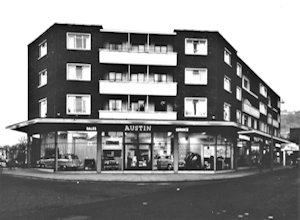
County Motors in the Stembrook complex on the corner of Church Street and Castle Street 1957. Dover Museum
County Motors and Henleys, the car dealers, amalgamated in 1960. A year later the company was operating under the sole ownership of Henleys on the corner of Church Street and Castle Street. Henleys also had a workshop in Dolphin Passage. 1962 marked the Diamond Jubilee of the Girls’ Life Brigade, an international and interdenominational Christian Youth Organisation founded 1902 and later amalgamated with the Girls’ Brigade. Two copper beech saplings were presented to the Mayor, Alderman Arthur James Husk (1909-1991) by Mrs Doris Myrtle Cook (1909-1994), captain of the 1st Dover Company, and Miss M Wells, captain of the St Martin’s Company.

Mayor Arthur Husk planting a tree to commemorate the Girls’ Life Brigade Centenary 1962. Dover Library
Janet Grant, a cadet from Salem Baptist Church and Mary Finch, a pioneer of the 2nd Company assisted the Mayor in planting the trees in Pencester Gardens. Mayor Husk, told the audience that ‘they heard a great deal about children getting into trouble, but if these children were to join organisations such as the Girls Life Brigade they would find something better, something worthwhile to do, and possibly a purpose in life.’ A plaque was erected to mark the occasion but within a few months it was stolen. Not long after it was replaced but that one was stolen in the 1970s, by which time the Company had been disbanded. In 1988 another plaque, marking a tree which had been planted by members of the Town Womens Guild founded in 1929, also disappeared. Some months later it turned up on the North Sea coast of Germany and was returned to the Guild. Inspired by the return of the Town Womens Guild’s plaque and the fact that the Girls’ Life Brigade tree was still flourishing, Mrs Cook contacted ‘Old Girls’ of the Life Brigade to instigate a re-union and erect a new plaque made of concrete!
Following the War, most of the properties along Pencester Road were repaired and together with Maison Dieu Road and Castle Street, the area became Dover’s professional district. Doctors, dentists, solicitors and estate agents etc. found the large residential properties suitable for conversion as they were close to the town centre yet relatively cheap to acquire.

East Kent Road Car Company bus shelter by the external bus services yard on the south side of Pencester Road c1986. Dover Distrcit Council
The East Kent Road Car Company (EKRCC) purchased the land where the large houses had once stood towards the eastern end of the southern side of Pencester Road. They also purchased properties on the opposite side of the road. Prior to the War, a quasi-bus station had evolved in Market Square but rapidly moved to Pencester Road when the Square was heavily bombed and shelled. EKRCC rebuilt their war damaged garage in the Russell Street area and it was assumed that a purpose built bus station would be built nearby. Both EKRCC and Dover Corporation agreed to this and in the interim it was also agreed that the company would use the land and properties they had bought on Pencester Road for a bus station. The properties on the north side of the road became a booking and enquiry office and the vacant land on the southern side a terminus for external bus services and coach services to London. Town bus stops and a passenger shelter was erected along the south side of Pencester Road ‘to be close to Pencester Gardens and the public lavatories.’
As time passed and the Dover bus station did not materialise, the Corporation believed and therefore planned that EKRCC would purchase and demolish properties along the north side of Pencester Road as they became vacant. This would then become Dover’s bus station and when seven properties on the north side of the road were put on the market councillors visited both Folkestone and Canterbury in anticipation. The Folkestone bus station had opened in July 1955 and Canterbury’s in May 1956. However, St Martins Property Corporation, formerly known as St. Martins-Le-Grand Property based in London, put in a higher bid than EKRCC. In 1964 they acquired and demolished the Pencester Road buildings and on the site they erected the shops with flats above that we see today.
About the same time the Stembrook car park, abutting the south side of Pencester Gardens was laid out but local garages monopolised the parking spaces for their new and used cars. In order to stop this, in 1968 charges were levied and a Traffic Warden employed to collect the money. It was the first fee paying car park in Dover and the charges were applicable between 09.00hours and 17.00hours, Monday to Friday.

Church Street showing Dicken’s corner and the Wilkins retained individual building styles. Alan Sencicle
The west side of Church Street, still retained scars of war damage and general neglect and according to Street Directories of the early 1960s, there was only the ancient Igglesden & Graves Bakers of Market Square bakehouse, the No 7 Club and Worsfold & Hayward’s auction rooms. It was on the steps of Igglesden & Graves that David Copperfield, in the Charles Dickens novel, rested before ascending Western Heights in search of his aunt, Betsy Trotwood. Back in 1905, the shop front on Market Square was rebuilt by local builder and undertaker, Charles Edwin Beaufoy (1869-1955) in a mock Tudor style that has since became iconic. In 1967, Igglesden & Graves was sold to John Wilkins, who had bought most of the neglected properties in Church Street for redevelopment. Wilkins promised to retain the iconic fronted building and Dover Town Council now own it. Wilkins also ensured that the Church Street properties retained much of their individuality and by the end of the decade they were all thriving businesses.
In Pencester Gardens, in 1970, a new, larger paddling pool replaced the post-war pool that had fallen into disrepair. At the same time, work started on building the town’s swimming baths in Woolcomber Street. Both pools proved to be very popular but sadly, towards the end of the summer of 1970, the paddling pool became the target of attacks by vandals and the cost of continual repairs forced the Corporation to close it. The swimming pool faired better and has now been replaced with a new facility at Whitfield.
The Corporation noted that charging for car parking at Stembrook would be lucrative if they did not have to employ car park attendants. They assumed that if car parking machines were installed, Traffic Wardens, as part of their other duties, could check the car park instead of having to employ someone to be there all the time. Therefore in 1972, Dover Corporation installed a parking ticket machine in Stembrook car park and charged 50pence a day – 09.00hours to 17.00hours Monday to Friday. Even before the machine was erected, the Corporation had decided that because it could operate 24hours a day 7 days a week and Traffic Wardens worked 24/7, they could extend parking charges to 24/7.
The machine was installed and in full working order, when on the following Sunday Fred Greenstreet (1905-1992), who owned a shoe shop in Bench Street and was a chorister at the nearby St Mary’s Church, parked his car in Stembrook. A Traffic Warden spotted this and Greenstreet was summoned to appear before the local magistrates. He was fined £2 but this he refused to pay and instead appealed at Canterbury Crown Court. There, Greenstreet pointed out that the Corporation had not applied for permission to erect the parking machine and his conviction was quashed. The Corporation were ordered to pay Mr Greenstreet £24 costs!
At the time the days of Dover Corporation were numbered due to the Reorganisation of Local Government Act being given Royal Assent in 1972. The new Act came into force on 1 April 1974 giving birth to Dover District Council (DDC), an amalgamation of four south-east Kent councils one of which was Dover Corporation. One of DDC’s many objectives was to rationalise and utilise the areas assets and council offices. Although Dover Corporation had promised that Pencester Gardens would get a new makeover, this was not forthcoming. Then, in November 1978, Gavin Astor, 2nd Baron Astor of Hever (1918-1984), visited Dover and planted oak trees in the Gardens to mark the 700th anniversary of the granting of the Great Charter of the Cinque Ports.
In the early 1980s three properties, which included the East Kent Road Car Company booking and enquiry office on the northern side of Pencester Road were demolished, with the properties on the opposite side of the Road, also demolished. At the time, it was still generally believed that this site would become part of the much needed town centre bus station and the East Kent Road Car Company had temporarily commandeered the southern site for over-night parking. Albeit, as part of the new DDC’s consolidation plans, they were building extensive Council offices on a greenfield site at Whitfield. As each phase was completed the administration moved, leaving their previous locations surplus to requirement and this included Dover Town Hall – the ancient Maison Dieu, Connaught Hall, the Magistrates Court and the Council Chambers. DDC, as a short-term policy, decided that the edifice would not be sold but instead it was retained to meet unaccounted demand.
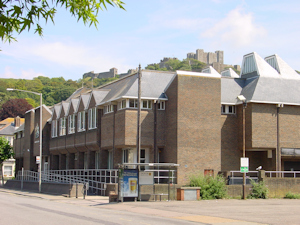
Pencester Road Magistrates Court opened December 1986 having cost £2million to build. Closed in 2017 and sold for £900,000. Alan Sencicle
This was generally accepted but the local solicitors and magistrates along with Kent County Council, pointed out that in 1976, two years after Re-organisation, the new DDC had promised a new Court Hall at the corner of Pencester Road and Maison Dieu Road. This was the same site that East Kent Road Car Company had also entered into an agreement with DDC for their new bus station! Subsequently, the Home Office gave approval for the new Magistrates Court to be built on the site. With five courtrooms plus associated offices and meeting rooms, the new court house was built by French Kier construction, services and property group of Bedfordshire. Costing £2million, it opened in December 1986 and in 2017 it closed and the building was sold to a property developer for £900,000. The area where East Kent Road Car Company booking office and enquiry office had stood was bought by DDC for £40,000, becoming a new car park for 55 vehicles.
East Kent Road Car Company, in the meantime, demanded another site as recompense for not getting the site where the new Court had been built. In the DDC 1986 Adopted Local Plan, the stated policy was, ‘TT21 The District Council will give sympathetic consideration to proposals to use land for Bus Parking subject to access and amenity considerations.’ The latter referred to Pencester Gardens, of which the bus company had demanded the northern part abutting Pencester Road, as compensation! During this time Dover Chamber of Commerce and Biggin Street traders joined forces and demanded a service road to be laid on the west side of the Gardens to provide a rear trade access for Biggin Street businesses – the total cost of that project was estimated at £12,000.

A large part of Pencester Gardens, in the mid-1980s, was under threat to be used for retail development. Alan Sencicle
In the mid-1980s DDC voted to upgrade the town of Dover and turn it into a major tourist destination. The council hired Hillier Parker, commercial property consultants and agents based in London. They published their advice in the September 1986 report, Assessment of the Potential for Retail, Commercial and Leisure Development in Dover. Knowing of the pressures facing DDC from the bus company and the Chamber of Commerce, their report backed both by advising that ‘Pencester Gardens is the location most likely to be successful in attracting institutional finance and retailers.’ Further, in line with DDC’s conviction of being able to turn Dover into a tourist destination, Hillier Parker built their main body of recommendations on a Heritage Centre in the Market Square area. This was close to where the magnificent Roman remains that had been unearthed a short while before but, with the exception of the Roman Painted House, had been carefully covered to enable conversion of York Street to a dual carriageway. (see Roman Painted House story).
Following the Consultants advice, John Clayton, the DDC Director of Planning and Technical Services, presented a Roman Heritage Centre scheme that focused on displaying many of the recently discovered archaeological finds. The Council were delighted with the proposed scheme and agreed that the Centre would be created in-house and be part of a Market Square redevelopment programme. Besides the Centre, the proposal would include a common entrance where a tourist information office would be located that would encourage visitors to see Dover’s many other historical sites, including the Roman Painted House.
Based on the Hillier Parker recommendation of a Heritage Centre, the London real estate services company Richard Ellis advised DDC councillors to visit the successful Jorvick Viking Centre in York. The Jorvick Viking Centre was created by the York Archaeological Trust in 1984 by graphic designer John Sunderland and described by Martyn Harris of the Daily Telegraph as ‘cosy and bowdlerised views of the past,’ (24 March 1989). Nonetheless, it has proved to be very successful and in the 1980s spawned many similar centres throughout the country. Following the visit, DDC councillors abandoned the idea of an in-house Roman Heritage Centre in favour of a Dover version of the Jorvick Centre designed by John Sunderland. This became the White Cliffs Experience and was given the go ahead at the estimated cost, including off-site parking, of £22million. Dover’s iconic Brook House and Dover Stage Hotel were demolished to make way for coach and car parks that were provided for the expected plethora of tourists.
The Hillier Parker and Richard Ellis consultants told DDC that the York Jorvik Centre effectively worked conjointly with the adjacent Coppergate shopping centre in attracting tourists. It was therefore suggested that a similar shopping centre could be sited on Pencester Gardens to complement the proposed White Cliffs Experience. Not only would such a scheme attract more visitors to Dover, they suggested that it could also help DDC to meet the costs of the White Cliffs Experience. With this in mind, it was implied, it could be financially expedient for DDC to offer both the White Cliffs Experience and the Pencester Gardens shopping centre projects to the private sector as a joint development venture, possibly as a lease-back arrangement.

DDC Finance Committee minutes – Pencester Gardens to be sold by lease back barter arrangement. 9 February 1988
The Councillors were told, in essence, a lease back arrangement was a financial transaction whereby DDC would sell the asset – in this case 2.25acres of the 3.75 acre Pencester Gardens – and lease the site back for long term use, such as retail development, even though they no longer owned the ground. The money DDC received for selling part of Pencester Gardens would go some way in paying for the White Cliffs Experience, which would significantly reduce the amount they needed to borrow. The proposal was unanimously agreed at a full council meeting held on 19 February 1988. To try and keep the general public happy, it was agreed to revamp the remaining part of Pencester Gardens at a cost of £180,000 and towards the end of 1988, the serpentine path along the Dour, that can still be seen today, was laid using brick. The Biggin Street traders were being kept happy by KCC purchasing the old St Mary’s Church Hall, on the west side of Pencester Gardens to provide a rear service road.

The lease back arrangement and the proposed retail development on Pencester Gardens were quietly dropped by DDC. The White Cliffs Experience was officially opened by Princess Anne in 1991. It closed on 17 December 2000 and was sold to Kent County Council for £1 and renamed the Dover Discovery Centre. Alan Sencicle
However, the District Auditor was not so happy with the arrangement for several reasons. These included: borrowing the amount need could incur heavy interest rates; the lease payments for the Pencester Gardens site were dependent on the prevailing interest rates and financial responsibility if either or both projects failed would incur heavy debts on DDC. The lease back arrangement and the proposed retail development on Pencester Gardens were quietly dropped by DDC. The White Cliffs Experience project did go ahead and was officially opened by Princess Anne in 1991. Possibly due to the number of other Heritage Centres that were proliferating around the country at the time, it failed to attract sufficient visitors to make return visits. On 17 December 2000, the White Cliffs Experience closed leaving DDC and in consequence the locals, with huge debts. The building was eventually sold to Kent County Council for £1 and renamed the Dover Discovery Centre.
The London real estate services company Richard Ellis that had proposed the lease back arrangement merged with CB Commercial, an American commercial real estate services and investment firm to form CB Richard Ellis in 1998. That same year, CB Richard Ellis acquired Hillier Parker, which had previously merged with May & Rowden. Eventually becoming the CBRE Group, Inc., the former DDC consultants, Hillier Parker and Richard Ellis are now part of the largest real estate and investment company in the world.
As noted above, when the lease back deal was being discussed DDC had agreed to revamp what would have remained of Pencester Gardens. Also, during that time, DDC had removed ornamental bushes, flower beds, donated trees, park seats and all but one of the commemorative plaques from the Gardens. Blithely, to justify this, DDC publicity department issued press statements ignoring the fact that they had removed the Pencester Gardens furniture to make way for the then proposed shopping mall. Instead, the DDC spokesperson said that they had been removed to enable tourists to see Dover Castle better and to stop mugging.
It was quickly pointed out that Pencester Gardens was in the valley while the Castle was on the top of the cliffs overlooking the said valley! As one local wit succinctly put it, ‘even gnomes would be able to see the Castle if the features had remained!’ As for mugging, DDC were officially informed by the police that not one case of mugging in Pencester Gardens had been reported! Instead of apologising, Councillors implied that their spokesperson had made a mistake and it was the ‘winos’ (their word) that was the problem. Further, that since the removal of the Gardens furniture, the ‘winos’ had moved into the ancient George IV Summerhouse, so it should be demolished. By a unanimous decision this was agreed and the deed was carried out. The general feeling in the town was that it was demolished out of vindictiveness and the resentment towards DDC increased.

Girls Life Brigade Diamond Jubilee commemorative copper beach tree and plaque presented in 1962 in Pencester Gardens. Alan Sencicle
Of interest the one plaque that remained in the Gardens was the Girls’ Life Brigade plaque – the third one after the previous two had been stolen – see above. Although the Girls’ Life Brigade in Dover had ceased to exist, Mrs Cook, the former Captain of the Dover Company, had instigated the erecting of a new vandal proof concrete plaque, next to the copper beach tree that they had planted to commemorate their Diamond Jubilee. Both the plaque and the tree are still there and the magnificent tree is now approximately 50feet tall!
Following the demise of the proposed Pencester Gardens shopping mall, KCC put the old St Mary’s Church Hall up for sale and for a long time after, this side of the Gardens was badly neglected. Albeit. to make amends over the debacle, in 1990-1991, DDC spent £71,000 undertaking a major Pencester Gardens environmental improvement scheme on the remainder of the site. This included an archway entrance, a large clock by the bus shelters on Pencester Road, a boundary of trees and shrubs, planting more shrubs, putting in benches and rebuilding the bridge over the River Dour. Brick to match the serpentine path replaced the tarmac paths that had crossed the Gardens since the 1950s – the brick serpentine path was later replaced with tarmac when it became a cycle route and when the clock times became idiosyncratic it was removed. The paths were also lit by the converted to electricity, original ornate gas lamps that had once stood in Market Square. The modern ornate lamps we see today later replaced the iconic former gas lamps.
Trustee Savings Bank took over the Henleys car show rooms in 1969 and Martin Walter car dealership had, on 31 December 1981, incorporated with Chatfields of Nottingham, founded in 1946. In the mid 1980s Martin Walter moved their workshop from the east side of Stembrook to car dealers, Henley’s, vacated workshop site across Castle Street in Dolphin Passage. B&Q, the national DIY and Home Improvement store bought and demolished the Martin Walter workshops and built a new store. Not long after, nationally, the B&Q Company was caught in a legal battle for opening on a Sunday thus violating the Shops Act 1950. While this was going through the courts the company bought the Dover Engineering site on Charlton Green and built a store that was more than twice the size of the Stembrook/ Castle Street store which opened in 1989.
On the first Sunday the new store had over 1,000 customers and was taken to court by DDC. B&Q closed their Stembrook/Castle Street store and on vacating those premises the building stayed empty for quite sometime before the Castle Street section was taken over by a home improvement business then a carpet company. The Stembrook section was eventually taken over by Kwik Save discount supermarket followed by Somerfield supermarket. Of note, the outcome of the B&Q Sunday Trading case led to the 1994 Sunday Trading Act that allows shops to open on Sundays but restricts the opening times of larger stores to a maximum of six hours between 10.00hrs and 18.00hrs only.

St Mary’s Church facing Stembrook with the small garden, paving and seating that was part of the 1990s IMPACT initiative. LS
About 1990 Martin Walter moved out of their car show rooms in the Stembrook complex on Castle Street, briefly Trustee Savings Bank moved in. The place was then taken over by the IMPACT Team a joint initiative of KCC, DDC and the European Development Fund. IMPACT put forward an environmental improvement scheme for the Stembrook area that centred on St Mary’s Church and the fact that the back of the Church is far more pleasing to the eye than the front! A line of semi-mature trees were planted framing the view of the Church and a small area was given over to a garden for annual flowering plants. Between the Stembrook retailer and the car park DDC built a distinctive new lavatory block. Close circuit television was introduced in the car park to discourage vandalism and high quality paving was used around the whole of the Stembrook area. More trees were to be planted in cast iron grills but costs stopped these and other aesthetic proposals.

Dover Society Plaque dedicated to William Burgess high up near the corner of the Stembrook and Castle Street. Alan Sencicle
At about the same time the Dover Society erected two blue plaques on the Stembrook complex. The first is high up on a wall near the corner of Stembrook and Castle Street. This is dedicated to arguably Dover’s greatest artist, William Burgess (1805-1861) – see Stembrook Tannery to Pencester Gardens Part One. The second plaque, shown above, is again high up but on the corner of Castle Street and Church Street and commemorates the last shell to hit Dover during World War II causing material damage. Another item of historic interest is below the River Dour bridge, close to the entrance into Stembrook from Castle Street. In the deep gully there are the remains of the former Stembrook corn mill’s wheel pit that, at times, can still be seen.
Another of the IMPACT initiatives was the Town Centre Management Company Ltd (TCM). The Chairman was Alan Elcocks – manager of Boots the Chemist, Biggin Street – and Kevin Gubbins was appointed the Town Centre Co-ordinator. Seven months later he resigned and was eventually followed by Tina Pullinger. When she left the title of the post was changed to Town Centre Manager with an office in the former car showroom complex. Mike Webb was appointed Town Centre Manager and his remit was, ‘to ensure that the town became a thriving community with profitable businesses, where residents are happy to shop and relax and a place that visitors would return.’
In 1996, under the persistent guidance of Councillor Lynette Young who was also elected Mayor that year, Dover received Parish Status. Dover Town Council, as they are called, occupied the former car showrooms / IMPACT offices until moving to Maison Dieu House in 2004. However, from the outset the relationship between the Town Council and the Town Centre Manager was fraught due to lack of clarity with regard to their different roles. In 2005, the Town Council appointed Mike Webb Dover Town Clerk, an appointment he held until he retired in 2011
The Dover Extra, a free local newspaper, which was letterbox delivered and available as a pick up was produced by the Kent Messenger Group of local newspapers. Initially, the Paper occupied premises on the east side of Church Street. At 07.20 one Monday morning in May 1996, a fire caused by an electrical fault started upstairs in the neighbouring premises of Felsons wine bar, snooker and pool club. Due to the heat, plastic pipes, containing beer, melted and part of the bar was flooded. Eventually, the beer seeped through the floor and the ceiling of the downstairs Dover Extra offices. This forced the paper’s only journalist, Graham Tutthill to abandon the place and work from home until the following weekend. That weekend he spent most of the time mopping up the beer, making repairs and decorating as well as generally making the offices smell less like a brewery. This was all much to the amusement of the significant number of staff who worked for the rival local paper, the Dover Express! The following year Radio Neptune, sponsored by the Kent Messenger Group, began broadcasting from the Extra’s Church Street offices.
Towards the end of 1998, DDC announced that they were going to install double-glazing in Pencester Court, make the flats safer and repaint the exterior walls. By this time the flats were 40 years old, had draughty ill fitting windows and were still without a lift. Added to this, said the residents who had signed a petition of complaint, was the noise that they had to put up with at weekends from revellers attending local night-clubs and public houses that included shouting and bad language. Further, when some events and the fairs were on in the Gardens, residents had to put up with flashing lights, loud generators and drunks using their doorways as public lavatories. The refurbishment took place shortly after the complaints were pubicised.
The western part of Pencester Gardens, as the 1990s progressed, looked increasingly abandoned a situation exacerbated by drug dealers moving in. The drug dealers who ran the operation were all heroin addicts and funded their own habits by selling £10 ‘wraps’ to customers, some as young as 15years of age. The actual sales took place in a nearby alley not covered by CCTV cameras and therefore, initially, it was difficult for concerned members of the public to prove to the police that anything untoward was happening. Albeit, the growing local pressure led to an undercover police operation and this resulted in the arrest of the thirteen-member gang. It was implied that those who complained were self-rightous busybodies but on sentencing the gang, Judge Giles Rooke (1930-2017) told the men, ‘The courts are bound to take a serious view of this because you are feeding the drug habits of others. It is corrupt and has to be punished.’ Following the trial, DDC agreed to use the area for a skateboard park, which opened in the early autumn of 1998 and proved popular from the outset.
Albeit, during the Fun Fair on Pencester Gardens in August 1999, riots broke out leaving 11 people wounded. The clash was between local youths and asylum seekers and, according to the national press, was fanned by the Far Right. Following the fracas the funfairs were cancelled but as Town Centre Manager, Mike Webb campaigned to bring the fair back to Dover. In 2004 fun fairs were reinstated with tighter security including a perimeter fence and guards and have been coming back during the summertime since. On each occasion, the fair has proved popular and there has not been a repetition of the events of 1999.
Celebrating the Millennium by creating a popular edifice occupied much of Dover Town Council’s time in the late 1990s and the favoured building was a performing arts pavilion on Pencester Gardens. Although eventually approved against opposition from Conservative Councillors over the cost, the proposed Millennium Pavilion was down graded to a Bandstand costing £80,000. Designed by Ole Selvaer of Selvaer Design of Castle Street, the style is a raised platform with an octagonal canopy shaped roof. It was built of brick with a concrete base, steel columns and roofing tiles that looked like lead. It was erected close to the River Dour with the Castle acting as a backdrop.
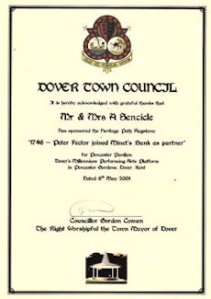
Millenium Bandstand, Pencester Gardens, Dover Town Council certificate for purchasing Peter Fector flagstone 2001.
St Mary’s Church of England Primary School, Laureston Place, placed a Time Capsule in the base of the new Bandstand for successive generations. Organisations and local folk were invited to buy paving stones – 100 slabs, inscribed with important dates in Dover’s history from £142 each. The Dover Society purchased two flagstones at a cost of £290: 1066 Norman invasion, Dover sacked and burnt and 1520 – Henry VIII and the Field of the Cloth of Gold. This author and her husband bought one commemorating 1746 – Peter Fector joined Minet’s Bank as a partner … from this partnership Peter Fector founded High Street Banking as we know it today.
The first live performance in the Pavilion, was a new musical work commissioned under Music 2000 – the Dover Millennium Arts Project and was performed by Cantium Brass. The Town Council organised bands to play at weekends during the summer of 2001 and although these proved popular, antisocial behaviour of individuals ensured that the events were spoilt such that they were eventually abandoned. Not satisfied with spoiling people’s enjoyment the vandals, possibly the same hooligans, smothered the pavilion with graffiti, stole the bricks from the edge of the platform area and destroyed many of the dedicated stones etc.
Dover Town Council planned that the Gardens would be the centre of the town’s Queen’s Golden Jubilee celebrations in June 2002 – if the hooligans could be kept at bay. Following discussions with the police it was agreed that the Council would use volunteer stewards to deal with problems and if matters started to get out of hand, the police would rapidly respond. The event, which was religious in nature, went off without incident as the volunteer stewards dealt quickly and quietly with potential troublemakers. The weather was warm and sunny and crowds, representing a multitude of faiths, came. The Bishop of Dover (1999-2009), the Right Reverend Stephen Venner, blessed them all.
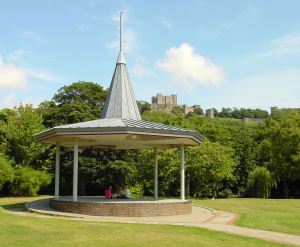
Pencester Gardens Millenium Bandstand against the backdrop of Dover Castle where successful productions and concerts were produced but local hooligans did their best to ruin. Alan Sencicle
At the end of June, a live Radio Kent broadcast came from Pencester Gardens featuring the Dover Youth Theatre’s production of Peter Pan by James Matthew Barrie (1860-1937) Although the weather could have been better the hooligans stayed away and the production was a great success. The band concerts continued throughout the summer and even though the hooligans started to do their best to spoil them volunteer stewards quickly and quietly saw them off. Nonetheless, following one of the last concerts of the season, the hooligans moved in one evening and smothered the pavilion with obscene graffiti. A few days later some 30 heavy engineering bricks that edged the stage were stolen. Both acts of vandalism were caught on CCTV, which was passed on to the police. However, some of the hooligans vociferous sympathetic relatives were supported by a local ‘human rights’ group. They loudly complained that the use of volunteer stewards by the Town Council, was a first step to vigilantism and should be stopped forthwith.
The following year, 2003, in accordance with a growing populist move to ban the use of volunteer stewards, they were not used. During one of the first concerts that year the hooligans, which had expanded their group to include a number of girls, descended. On their way to Pencester Gardens they had attacked a number of other youngsters and on arrival in the Gardens they did their worst … in the name of ‘human rights.’ The concert was abandoned following which an angry letter from a member of the audience telling of what had happened, was published in a local paper. It finished by the author demanding the return of the volunteer stewards.
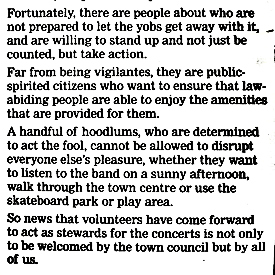
Graham Tutthill’s Leader in the Dover Mercury 15 May 2003 supporting volunteer stewards for Pencester Gardens concerts.
This gave rise to a volume of condemnation of volunteer stewards from folk who had not attended the Pencester Gardens concert. In essence, they said that the volunteer stewards were vigilantes and therefore unlawful. However, Graham Tutthill of the Dover Mercury on 15 May 2003 responded in its Leader column saying that the volunteers ‘Far from being vigilantes, they are public-spirited citizens who want to ensure that law-abiding people are able to enjoy the amenities that are provided for them.’ Sometime later a well-publicised national production of Richard III by William Shakespeare (1564-1616) was performed in Pencester Gardens. The hooligans and their girl friends arrogantly descended, armed with paint, called the volunteer stewards ‘f****** vigilantes’ and they knew their ‘rights’. The volunteer stewards supported by the local police met them and the hooligans hastily left. The production was a great success.
The summer of 2004, with the volunteer stewards and some police officers in attendance, saw not only successful band performances. In June 2004, Dover’s first Multicultural Festival took place to coincide with Refugee Week and the next month the Dover Youth Theatre put on their production of Wind in the Willows by Kenneth Grahame (1859-1932). Both were successful although the weather did its best to provide plenty of wind for the theatre production! The post-war annual hospital fete run jointly by the Dover Rotary Club and the Dover Hospital League of Friends – founded by Ron Proudler (d1993), celebrated its 50th anniversary in the Gardens. Dentist, Ron Proudler, was the National President of Rotary International in Britain and Ireland in 1970 -1971 and on his retirement went to live in Eastbourne. The Fun Fair returned to Pencester Gardens in 2004 with 16,000 people attending and towards the end of the summer, members of the SK8 part of the DDC Youth Forum were invited to draw up plans to improve and rebuild the existing Skateboard Park in Pencester Gardens as well as another one in Deal. KCC gave £20,000 towards the £100,000 project and in 2007 the new extended Skateboard Park opened.
The following year, 2005, the refurbished children’s play area reopened and was paid for by a £257,702 lottery grant. It was designed to encourage creative play but unfortunately, the hooligans – both sexes – again returned to the Gardens. They punched anyone who got in their way as they attacked the facilities. The police were called and several were arrested. Others received fixed penalty fines as well as banning orders stopping them coming into the area for up to 48hours. Following the disturbance the police maintained high-visibility presence for the remainder of the summer and the hooligans gradually found better things to do. Since then the play area was, and still is, well used, as is the extended skateboard park.
In 2009 the Co-operative Group acquired the Somerfield supermarket chain and invested £240,000 on refurbishing the former store, which opened in July 2010 – bringing a Co-op back to the centre of Dover. Shortly after they entered into a concession with Peacock clothing store, based in Cardiff, to operate in part of their premises. The Carlisle based national retailer, Edinburgh Wool Mill, in 2012 bought the Peacocks clothing chain retaining the name. Their purchase also included the Peacock store in Biggin Street and so they subsequently closed the concession store in the Stembrook Co-op. On the north side of Pencester Gardens Dover’s magistrate court, on Pencester Road, was down graded to a legal administrative building and more recently the building was put on the market. It is believed that the site is to be used for housing development. Although the Pencester Road bus facilities offer coach services to London, buses to local towns and some services within Dover, the promised Dover bus station has not yet materialised.
Stembrook, although looking very attractive following the IMPACT refurbishment, has only been intermittently maintained. DDC announced, as a cost saving measure in 2010, that they were closing all of Dover’s public lavatories with the exception of those at Stembrook. At the time the centre of their attention was on what is now the £53million St James retail and leisure complex, to the south of Castle Street. In November 2016 the Co-operative Group announced that they would be closing their Stembrook supermarket on Saturday 11 February 2017. The empty premises accentuated what was rapidly becoming a run down feeling to this part of Stembrook that was accentuated around the public lavatories due to evidence of drug abuse.
DDC acquired the former Co-operative building in April 2018, as part of its town centre regeneration and property investment plans and planned to convert the retail building into an innovation warehouse. Where, DDC said, ‘Incubator spaces will give fledgling firms a chance to get established and provide a stepping stone to moving into permanent premises in the town centre.‘ The next month DDC met with Dover Big Local – a community-led lottery-funded organisation with the remit to make Dover a better place to live. The objective of the meeting was to discuss the state of Cannon Street and Biggin Street, where many retail units were boarded up. Unfortunately, they felt that very little could be done as most of the closed retail units are owned by out-of-town landlords.
This justified DDC’s remit for purchasing the Stembrook building as it was acquired to provide ‘business office space allowing entrepreneurs to move out of their front rooms or off the kitchen table into a form of serviced premises. The concept aimed to reduce the risk to these small budding enterprises in trying out their ideas and business models.’ The Co-Innovation Centre, as it is called, opened in 2018 and small start-up businesses quickly moved in. However, it soon became apparent that there was a demand for a ‘maker/seller’ market, where operators could make and sell their wares within the same space. At the time of writing, the building hosts a range of shops and offices, a cafe, leisure activities for the very young and the not so young together with meeting and conference facilities. Recently, the ‘maker/seller’ market was rebranded as Stembrook Lane Shopping Arcade in anticipation of appealing to the cruise and other tourist markets.
Pencester Gardens, Pencester Court, Stembrook development, St Mary’s Church, together with the small number of shops and the Co-Innovation Centre have the potential to be a special part of Dover town centre. Sadly, these days, concerts and theatrical productions are few and far between and further, there is a small minority of people who frequently consume copious amounts of alcohol in the Gardens and this leads to them behaving antisocially. Nonetheless, festivals are held in the Gardens every year and continue to increase in number, popularity and in the variety of content.
The Fun Fair has continued to come to Dover and remains great fun without the troubles seen in 1999. The commemorative trees planted in the past are now mature and although out numbered by herring gulls, rooks have set up home in the Gardens. The rooks probably came from the vicinity of Brook House when the iconic building was demolished and a car park was laid on the site. Brook House was built on part of the great Stokes-Wyvell-Gunman-Jarvis estate to which the Pencester Gardens land once belonged. (see Part I of Stembrook Tannery to Pencester Gardens). Both the skate park and the youngsters play area remain popular and the seating enables people to sit and watch the world walk by.
Presented: 17 May 2019


